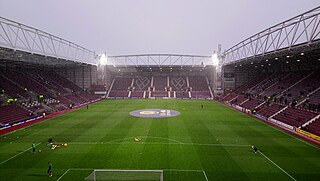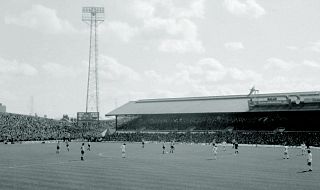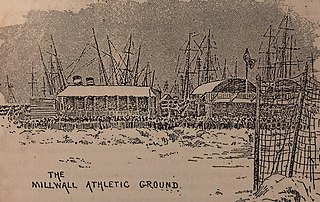
Craven Cottage is a football stadium in Fulham, West London, England, which has been the home of Fulham since 1896. The ground's capacity is 22,384; the record attendance is 49,335, for a game against Millwall in 1938. Next to Bishop's Park on the banks of the River Thames, it was originally a royal hunting lodge and has a history dating back over 300 years.

Eamon Martin Dunphy is an Irish media personality, journalist, broadcaster, author, sports pundit and former professional footballer. He grew up playing football for several youth teams including Stella Maris. Since retiring from the sport, he has become recognisable to Irish television audiences as a football analyst during coverage of the Premier League, UEFA Champions League and international football on RTÉ.

Millwall Football Club is a professional Association football club in Bermondsey, South East London, England. They compete in the EFL Championship, the second tier of English football. Founded as Millwall Rovers in 1885, the club has retained its name despite having last played in the Millwall area of the Isle of Dogs in 1910. From then until 1993, the club played at what is now called The Old Den in New Cross, before moving to its current home stadium nearby, called The Den. The traditional club crest is a lion rampant, referred to in the team's nickname 'The Lions'. Millwall's traditional kit consists of dark blue shirts, white shorts, and blue socks.

Doncaster Rovers Football Club is a professional association football club based in Doncaster, South Yorkshire, England. The team compete in League Two, the fourth tier of the English football league system. The club play their home games at The Eco-Power Stadium, having moved from Belle Vue in 2007. Their home strip consists of red and white hoops, which has been the main design of the club's home shirt since 2001 through different variations.

Woking Football Club is a professional association football club, based in Woking, Surrey, England. Founded in 1887, the club plays its home matches at The Laithwaite Community Stadium and is nicknamed the Cardinals, often shortened to the Cards. Currently, they compete in the National League, the fifth tier of English football, having been promoted from the National League South in the 2018–19 season.

Rugby Park, also known as The BBSP Stadium Rugby Park for sponsorship reasons, is a football stadium situated in the Scottish town of Kilmarnock. It was first used in 1899 and is the home of Kilmarnock F.C. Rugby Park has also been used for concerts, with Elton John playing to 15,000. In 2002, the club constructed the Park Hotel, a 4-star hotel complex next to the ground.

Tynecastle Park is a football stadium in the Gorgie area of Edinburgh, which is the home ground of Scottish Professional Football League club Heart of Midlothian (Hearts). It has also hosted Scotland international matches, and been used as a neutral venue for Scottish Cup and Scottish League Cup semi-finals. Tynecastle has a seating capacity of 19,852, which makes it the sixth-largest football stadium in Scotland. Hearts have played at the present site of Tynecastle since 1886.

Roker Park was a football ground in Roker, Sunderland, England, which was the home of Sunderland A.F.C. from 1898 to 1997, before the club moved to the Stadium of Light. Its final capacity was around 22,500, with only a small part being seated; it had been much higher, attracting a record crowd of 75,118.

The Den is a football stadium in Bermondsey, south-east London, and the home of Millwall Football Club. The Den is adjacent to the South London railway originating at London Bridge, and a quarter-of-a-mile from the Old Den, which it replaced in 1993.
The 1989–90 season was the 110th season of competitive football in England.

Prenton Park is a large outdoor seated association football stadium in Birkenhead, England. It is the home ground of Tranmere Rovers, as well as Liverpool's women and reserves teams. The ground has had several rebuilds, with the most recent occurring in 1995 in response to the requirement of the Taylor Report to become all-seater. Today's stadium holds 16,587 in four stands: the Kop, the Johnny King Stand, the Main Stand and the Cowshed.
The Millwall Bushwackers are a football firm associated with Millwall Football Club. Millwall have a historic association with football hooliganism, which came to prevalence in the 1970s and 1980s, with a firm known originally as F-Troop, eventually becoming more widely known as the Millwall Bushwackers, who were one of the most notorious hooligan gangs in England. On five occasions The Den was closed by the Football Association and the club has received numerous fines for crowd disorder. Millwall's hooligans are regarded by their rivals as amongst the stiffest competition, with Manchester United hooligan Colin Blaney describing them as being amongst the top four firms in his autobiography 'Undesirables', and West Ham hooligan Cass Pennant featuring them on his Top Boys TV YouTube channel, on which their fearsome reputation for violence was described.
The 1994–95 Football League season was the 96th completed season of The Football League. It was the third season of The Football League since the formation of the Premier League. For sponsorship reasons, the league was known as the Endsleigh League.

The rivalry between Millwall and West Ham United is one of the longest-standing and most bitter in English football. The two teams, then known as Millwall Athletic and Thames Ironworks, both originated in the East End of London, and were located less than three miles apart. They first played each other in the 1899–1900 FA Cup. The match was historically known as the Dockers derby, as both sets of supporters were predominantly dockers at shipyards on either side of the River Thames. Consequently, each set of fans worked for rival firms who were competing for the same business; this intensified the tension between the teams. In 1904, West Ham moved to the Boleyn Ground which was then part of Essex until a London boundary change in 1965. In 1910, Millwall moved across the River Thames to New Cross in South East London and the teams were no longer East London neighbours. Both sides have relocated since, but remain just under four miles apart. Millwall moved to The Den in Bermondsey in 1993 and West Ham to the London Stadium in Stratford in 2016.

The 1985 Luton riot occurred before, during and after a 1984–85 FA Cup sixth-round football match between Luton Town and Millwall on 13 March 1985 at Luton Town's Kenilworth Road ground in Luton, Bedfordshire, England. It was one of the worst incidents of football hooliganism during the 1980s, and led to a ban on away supporters by Luton Town which lasted for four seasons. This itself led to Luton's expulsion from the Football League Cup during the 1986–87 season. The club also began to enforce a membership card scheme, which Margaret Thatcher's government attempted to have adopted at grounds across England. Kenilworth Road was damaged, along with the surrounding area, and a year later was converted to an all-seater stadium.
The history of Millwall Football Club, a professional association football club based in Bermondsey, South East London, England, dates back to the club's formation in 1885 as Millwall Rovers.

The South London derby is the name given to a football derby contested by any two of Charlton Athletic, Crystal Palace, Millwall, Sutton United, and AFC Wimbledon, the five professional Football Association clubs that play in the Football League in South London, England. It is sometimes more specifically called the South East London derby when played between Charlton and Millwall. The close geographical proximity of all the teams contributes significantly to the rivalries.

The Athletic Grounds was a football ground and the home of Millwall Athletic Football Club from 1890–1901, the team who went on to become Millwall. It was situated on the Isle of Dogs, East London. It was the third stadium Millwall had occupied since their formation as a football club in 1885. Millwall were formidable at the Athletic Grounds, winning 73% of their games. In total they played 147 games here in all competitions, winning 108, losing 24 and drawing 15.

The rivalry between Leeds United and Millwall is a bitter North–South divide rivalry in English football. Millwall were founded in London in 1885 and Leeds United in Yorkshire in 1919, over 170 miles (270 km) apart. Both sides entered the Football League in 1920–21 season, albeit in different divisions. From 1920 to 2003 the sides met just 12 times; competing in different tiers for the majority of their histories, and neither considering the other a rival on the pitch. From 2004 to 2020, the teams met 28 times when Leeds were relegated from the Premier League. The rivalry began in League One during the 2007–08 season, with disorder and violent clashes between both sets of fans and the police at Elland Road. It continued into the 2008–09 season; where the teams were vying for promotion to the Championship, culminating in Millwall knocking Leeds out of the League One playoffs at the semi-final stage.
















